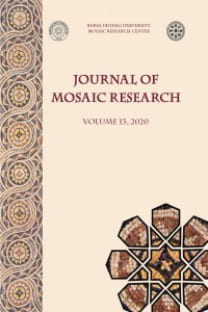Some Considerations on the Interplay Composition - Surface
When analysing different floors of Roman mosaic, it must be noted that the choice of the iconographic programfor the decoration of one or more spaces in the same building follows, in general, the guidelines given by thecommissioner of the work according to his preferences or the objectives of representativeness that he hopes toachieve through that program.However, the adaptation of the chosen composition to the surface to be decorated is surely up to the mosaicartists. According to their expertise and probably also to the budget allocated to the work, they will adapt thecomposition as a whole and the integrated patterns (present therein) to the measurements of the surface to bedecorated.The analysis of these elements is mainly decisive in the study of pavements with compositions based on geometricschemes.
Keywords:
Roman mosaic, composition, style, patterns space planning,
___
- Alves 2002 F. D. A. C. C. O. Alves, A Arquitectura e o mosaico romano de pavimento. Relações/Interacções, Dissertação de Mestrado em História da Arte, História da Arte da Antiguidade, Faculdade de Ciências Sociais e Humanas, Universidade Nova de Lisboa.
- Baum-vom Felde 2003 P. C. Baum-vom Felde, Die geometrischen Mosaiken der Villa bei Piazza Armerina, Analyse und Werkstattfrage, Vol. I, II, Hamburg.
- Campos Carrasco et al. 2008 J. M. Campos Carrasco - A. Fernández Ugalde - S. García Dils - Á. Gómez Rodríguez - J. Lancha - C. Oliveira - J. F. De Rueda Roigé - N. De La O Vidal Teruel (Equipa MOSUDHIS), A rota do Mosaico Romano. O Sul da Hispânia (Andaluzia e Algarve), Cidades e villae notáveis da Bética e Lusitânia romanas, Faro.
- Correia 2013 V. H. Correia, A Arquitectura Doméstica de Conimbriga e as Estruturas Económicas e Sociais da Cidade Romana, Anexos de Conimbriga nº 6. Centro de Estudos Arqueológicos das Universidades de Coimbra e Porto, DGPC, Liga de Amigos de Coimbra.
- Décor I C. Balmelle – M. Blanchard Lemée – J. Christophe – J.-P. Darmon – A.-M. Guimier Sorbets – H. Lavagne – R. Prudhomme – H. Stern, Le Décor Géométrique de la Mosaïque Romaine I, Paris, 1985.
- Décor II C. Balmelle – M. Blanchard Lemée – J.-P. Darmon – S. Gozlan – M.-P. Raynaud, Le Décor Géométrique de la Mosaïque Romaine II, Paris, 2002.
- Dunbabin 1999 K. M. D. Dunbabin, Mosaics of the Greek and Roman World, Cambridge.
- Duran Kremer 1999 M. J. Duran Kremer, “Die Mosaiken der villa cardilio (Torres Novas, Portugal), Ihre Einordnung in die musivische Landschaft der Hispania im allgemeinen und der Lusitania im besonderen“, Inaugural-Dissertation zur Erlangung des Doktorgrades (Dr. phil.) im Fachbereich III der Universität Trier, Band I bis IV., Trier.
- Duran Kremer 2005 M. J. Duran Kremer, “Algumas consideraçoes sobre a representação das estações do ano em mosaicos da Península Ibérica”, O Mosaico Romano nos centros e nas periferias. Originalidades, influûencias e identidades, Actas X do Colóquio Internacional do Mosaico Greco-Romano, Conimbriga, 189-202.
- Duran Kremer 2008 M. J. Duran Kremer, “A villa romana da Abicada. Uma introdução ao estudo da arquitectura e mosaicos”, XELB 8, 213-222.
- Lancha - André 2000 J. Lancha - P. André, Corpus dos Mosaicos Romanos de Portugal. A Villa de Torre da Palma, Vol. 1, 2, Lisboa.
- Oliveira 2010 C. F. de Oliveira, Mosaicos Romanos de Portugal. O Algarve Oriental. Vol.I (1) (2), Vol.II. Dissertação de Doutoramento em História, Coimbra.
- Salies 1974 G. Salies, Untersuchungen zu den geometrischen Gliederungsschemata römischer Mosaiken, BJb 174.
- ISSN: 1309-047X
- Yayın Aralığı: 1
- Başlangıç: 2008
- Yayıncı: Ululdağ Üniversitesi, Mozaik Araştırlmaları Merkezi
